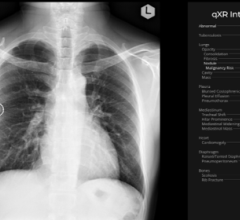
August 20, 2015 — Non-invasive stereotactic body radiation therapy (SBRT) is effective and well-tolerated by patients with inoperable early-stage or node-negative non-small cell lung cancer (NSCLC) tumors larger than 5 cm, according to a study published in the International Journal of Radiation Oncology Biology Physics.
The study involved the use of SBRT — which precisely delivers a high-dose beam of radiation to target tumors while minimizing dose to the surrounding healthy tissue — for the treatment of frail patients with large inoperable lung tumors and without lymph node involvement. SBRT, which makes it possible to complete treatments in fewer sessions than conventional radiation therapy, has not typically been used to treat large tumors.
Results from SBRT were compared with literature on outcomes from conventional lung surgery. The research suggests that non-invasive SBRT may be a viable treatment alternative to conventional surgery for some patients with larger lung tumors.
"Our study shows that lung SBRT can be used to safely treat localized node-negative inoperable NSCLC tumors larger than 5 cm, with low rates of recurrence at the primary tumor site and with minimal side effects," said Gregory M. M. Videtic, M.D., CM, FRCP, from the Department of Radiation Oncology at the Cleveland Clinic Taussig Cancer Institute, and professor of medicine at the Cleveland Clinic Lerner College of Medicine of Case Western Reserve University.
Prior to the emergence of lung SBRT, frail medically compromised patients with node-negative inoperable NSCLC were often treated with external beam radiation therapy, which delivers lower doses over a higher number of treatment sessions. However, these patients often experienced a high rate of disease recurrence along with significant side effects. Lung SBRT has become routine for treating small NSCLC tumors, typically less than 3 cm, because of its high rate of local control and limited toxicity. The research by Videtic and his colleagues is one of the few studies on the use of lung SBRT in larger tumors.
In their retrospective study, Videtic and his team evaluated the outcomes of 40 patients with node-negative, medically inoperable NSCLC whose primary tumors were greater than 5 cm and who were treated with SBRT between December 2003 and June 2014.
The study reviewed patients' outcomes at 18 months after treatment. Local control, which means there was no evidence of disease at the original tumor site, was achieved in 91.2 percent of cases. The percentage of patients who experienced distant failure where cancer had spread to other parts of the body was 32.5 percent. When these results were compared to published surgical studies, lung SBRT appeared to have similar rates of local control and similar rates of distant failure.
Disease-free survival in patients who had no lung cancer present at 18 months after treatment was 34.6 percent. The overall survival rate at 18 months, including disease-free patients and those who still had evidence of lung cancer, was 59.7 percent. "The overall survival rates are lower in medically inoperable patients receiving lung SBRT compared to operable surgical patients," said Videtic. "However, the lower survival rate in medically inoperable patients may be due to the presence of other non-cancer related conditions, such as chronic obstructive pulmonary disease, commonly found in inoperable patients."
The percentage of SBRT patients who were free of side effects was 70.5 percent. Side effects observed from SBRT included mild chest wall pain and modest inflammation in lung tissue. In two severe cases, patients experienced excessive fluid build-up in the lung and a lung collapse due to inflammation that blocked the airways.
The research team concluded: "Lung SBRT for medically inoperable node-negative NSCLC tumors larger than 5 cm provides excellent local control with limited toxicity. With appropriate patient selection, SBRT is safe and efficacious for larger tumors."
For more information: www.varian.com


 December 11, 2025
December 11, 2025 









